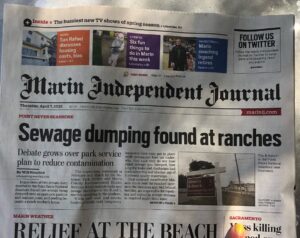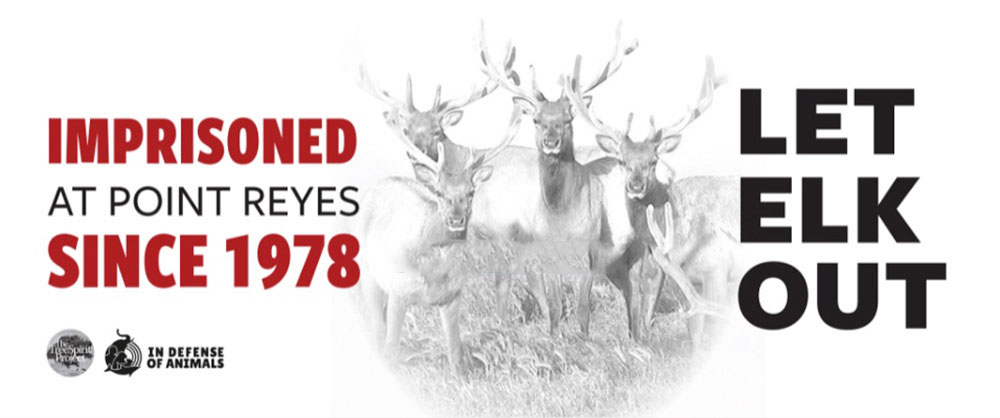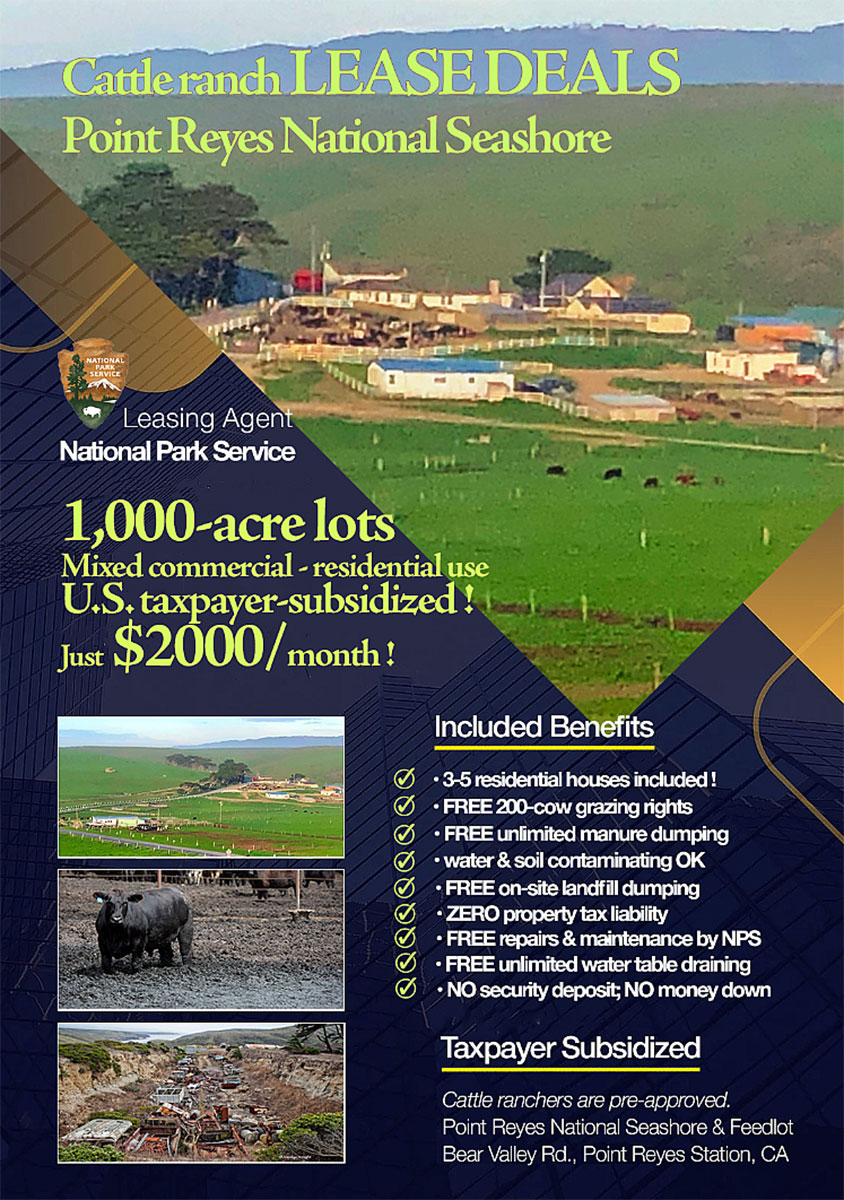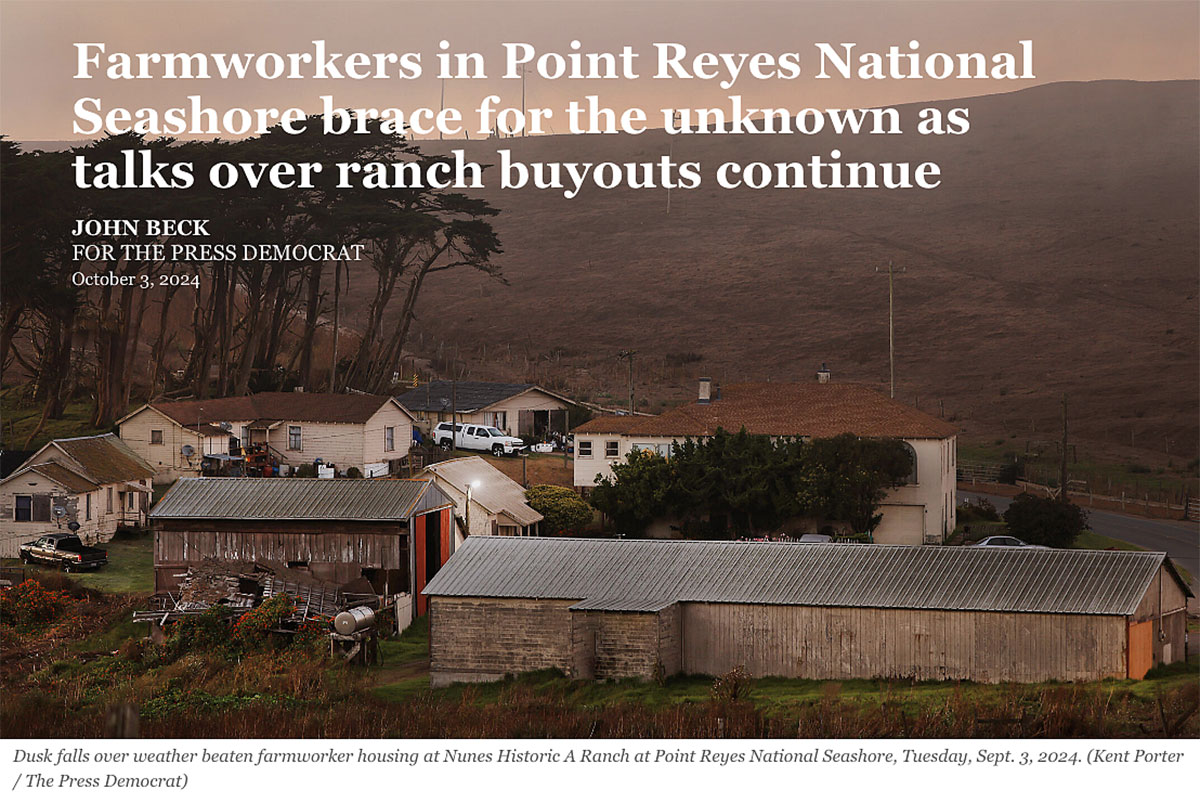LITIGATION, LAWYERS & LIES
We activists, wild animal protectors, and national park advocates were all primed to watch the latest court proceedings, on Friday, October 18th (2024), for one of the two ongoing lawsuits involving Point Reyes National Seashore. Either lawsuit, in different ways, could result in finally freeing the magnificent Tule elk from the park’s so-called Tule Elk Reserve at Tomales Point (northernmost Point Reyes), which is their fenced compound inside this national park unit. It was erected solely to benefit private cattle ranchers, and at the expense of its prisoners, the re-introduced Tule elk when just 10 Tule elk were brought back to Point Reyes in 1978.
The Tule elk, native to California and have lived on the Point Reyes peninsula, and far beyond, for tens of thousands of years before being extirpated (made locally extinct) by European settlers (including so they could raise domesticated cows for human consumption). Which by the way, is a universally acknowledged impressive achievement by the National Park Service — and, notably, one that defied ranchers wishes for an elk-free, cattle-filled park.
Remember, the NPS (National Park Service) is leasing public land to the private-profit ranchers whose beef and dairy operations are actively polluting Point Reyes, as they have for decades. Ranchers of course want any threat, any nuisance, to their for-profit businesses suppressed, and this includes the wild animals in a national park; they want to keep the Reserve’s Tule elk fenced in on 2,600 acres, and blocked from accessing the park’s full 71,000 acres.
So, in court, at the proverbial last-minute, as in a TV procedural, an attorney who is friendly to ranchers — and related by both ideology and blood — just filed a brief with the U.S. District Court (in San Francisco, CA) presiding over the case. He, Andrew Giacomini, petitioned the court to add additional “stakeholders” to the long-running case, requesting that additional parties be given a “seat at the table.” Never mind that the case has been in negotiations for over 2 years, between the three environmental org plaintiffs (CBD, WWP, RRI) and the defendant, the Park Service. It’s never too late to pull a last-minute, Hail Mary legal stunt.
REAL WORKER SYMPATHY,
BOGUS RANCHER EMPATHY
Which additional parties? Two ranch workers employed by the cattle operators. They are undocumented immigrants who live on site. The public isn’t explicitly told, but from some local newspaper articles, ranch hands apparently earn low wages, have no benefits and no job security. This suddenly relevant employment information is concealed, as is so much about these cattle operations — including their huge public tax dollar subsidies. (More on those in a moment.) More questions: do ranches charge their workers to live on site? Are they extracting rent which could easily (and in our opinion, likely) turn ranches a profit? This would constitute illegal subletting ranch structures, as worker housing, since that would require written prior NPS approval. And park rules stipulate that only park employees can reside in park housing. We assume ranchers are the exception, and written into leases, but what about their employees?
Back to the matter of the public — you, dear reader — subsidizing private cattle businesses in this public, federal park.
1,000-ACRE OCEANFRONT RENTALS – FOR A SONG
Guess what one of the ranches pays in rent to its NPS landlord? I-Ranch has 1,017 acres of oceanfront property and 8,105 sq. ft. of housing. Go on, take a guess – – what would you expect to pay for this much land and housing, even if the houses were old, inside a national park in affluent Marin County, CA? You won’t guess correctly.
It’s less than what many people pay to rent a 1-bedroom in nearby, affluent Inverness, or Mill Valley, or San Anselmo. In San Francisco, just 20 miles south, you’d be lucky to find a 1,200 sq. ft. 1-bedroom apartment with 1/10th of an acre of outdoor space. If you were lucky, you’d score that for only $3,500/month — which is what the I-Ranch’s owner pays for his spread.
YOU SHOULD BE SO LUCKY TO HAVE IT AS “HARD” AS Point Reyes RANCHERS
So the next time you feel sympathy while reading another local newspaper story about the poor, struggling, hardworking Point Reyes ranchers — whose businesses are still polluting Point Reyes with thousands of pounds of manure every year — don’t. Their operations are not milking just cows, they’re also keep milking the public.
The two ranch workers being shoe-horned into this lawsuit are among an estimated 65 ranch workers living at the Seashore, in poorly maintained structures. They do the dirty farm work their well-to-do owners don’t. The worker’s attorney, Giacomini, says he wants more or even all of the workers to join his suit. Of course he does. He’d love to divert attention from the many violations of the ranchers, and instead keep attention focused on the workers — while also ignoring that they are, as they have always been, exploited by the ranchers.
For all the public knows — which is typically little since ranchers work hard to suppress basic, damning facts like their jumbo public subsidies — ranchers could be subletting to their workers at cheap rents, or docking worker pay like sharecroppers. I-Ranch could easily be turning a profit with illegal sublets alone, because who would know, and who would stop them? That’s what this lawsuit brought by plaintiffs Western Watersheds Project, Center for Biological Diversity, and Resource Renewal Institute is all about, demanding the National Park Service to hold ranchers responsible for all their many violations, not least of which is manure pollution of a national park unit.
Ranchers have, for example, been skirting and violating county, state and federal water pollution regulations in Point Reyes for decades, with little to no oversight and enforcement. What’s one more criminal behavior from these “hardworking stewards of the land,” as their publicity machine often describes them.
The new court filing is only the latest in the ranchers’ steady stream of clever legal and political maneuvers, ongoing since the 1960s. Along with the P.R. campaigns telling the public how necessary their businesses are for the local economy, and for job creation. Which is more disinformation of course. Tourism is far more valuable to the local economy and, more important, doesn’t do the massive environmental damage the cow business does.
The attempt to inject ranch hands into the negotiations is cleverly designed to tug on public heartstrings, exploiting real, appropriate sympathy for low-wage, politically powerless immigrant workers. And how perfectly, appropropriately Trumpian; to beat workers down, and then hold them up as victims to extract public sympathy — and more public money — for their exploiter employers.
NO 40 ACRES, AND NO MULE EITHER
If ranchers actually cared about their workers, they could have, years ago, given them better pay, benefits, even profit-sharing for some security. If this lawyer genuinely cared about these workers, why not bring a suit on their behalf years ago? Or better yet, file suit against their low-paying employers, the ranchers, instead of against the rancher’s landlord, the NPS?
 Although ranch worker salaries are not disclosed, journalists have documented their dilapidated, on-site housing: dilapidated structures with crumbling floors, leaking ceilings, and poorly maintained septic systems. These have all made headlines, including human sewage spilling on the land, where it mixes with cow manure. A double dose of fecal contamination for park soil and its public waterways. Hence the bitter activist’s pseudonym, Point Reyes National Cesspool.
Although ranch worker salaries are not disclosed, journalists have documented their dilapidated, on-site housing: dilapidated structures with crumbling floors, leaking ceilings, and poorly maintained septic systems. These have all made headlines, including human sewage spilling on the land, where it mixes with cow manure. A double dose of fecal contamination for park soil and its public waterways. Hence the bitter activist’s pseudonym, Point Reyes National Cesspool.
But this latest legal gambit will achieve its goal: successfully delaying the resolution of this “3 orgs” — Western Watersheds Project, Center for Biological Diversity, and Resource Renewal Institute — lawsuit until well after Election Day — and likely into 2025. Ranchers, we speculate, would love to pull another Trump, and stall any settlement until Trump himself might take the White House, which oversees the U.S. Interior Dept., which oversees the Park Service, which runs Point Reyes Seashore. If anyone would simply wipe the legal gameboard clear, it’d be Trump. Who is better suited to do the rancher’s bidding, to break with precedent, flout rules and laws, and do a lawless favor for those who pledge allegiance to His Orangeness über alles?
STINKY RANCHES, STINKY TACTICS
Like the millions of pounds of manure the park’s ranchers dump every single year into this national park, this last-minute filing stinks. Will the judge summarily dismiss it for being an obvious ploy? Maybe, but then she’d be turning a very public back to workers who have and deserve public sympathy. She could just as easily bow to the political pressure of this legal Hail Mary impasse, and grant a hearing, and thus more delay. Which is yet another Trumpian tactic: fight and delay, deny and ignore, truth be damned, thank you Roy Cohn.
We’ll learn the answer to the judge’s Hobson’s choice on Friday, November 22nd, when presiding U.S. Distric Court Judge Maxine Chesney holds the next scheduling hearing in San Francisco, which is currently scheduled for public viewing via Zoom. We’ll keep you posted as that date nears.
WHY LITTLE Point Reyes MATTERS SO MUCH
In the meantime, please share this blog and spread the word about what’s going on inside little Point Reyes Seashore. Why? Because this conflict is about more than the park’s Tule elk, even though the elk are reason enough to fight to free this park free of its private, polluting cattle businesses. It’s because the cattle business — despite the nostalgic “happy cow” mythologies that work to keep it running — are really a blight on the land.
READ MORE ABOUT eating animals.
Today, in the 21st century, the world’s beef and dairy operations are a primary driver of the global heating climate emergency. Which is why the party of Trump must deny scientifically established truths about the cattle business, about global heating, and about science itself — or else these pillars of the tower of climate and environmental lies would come crashing down.




